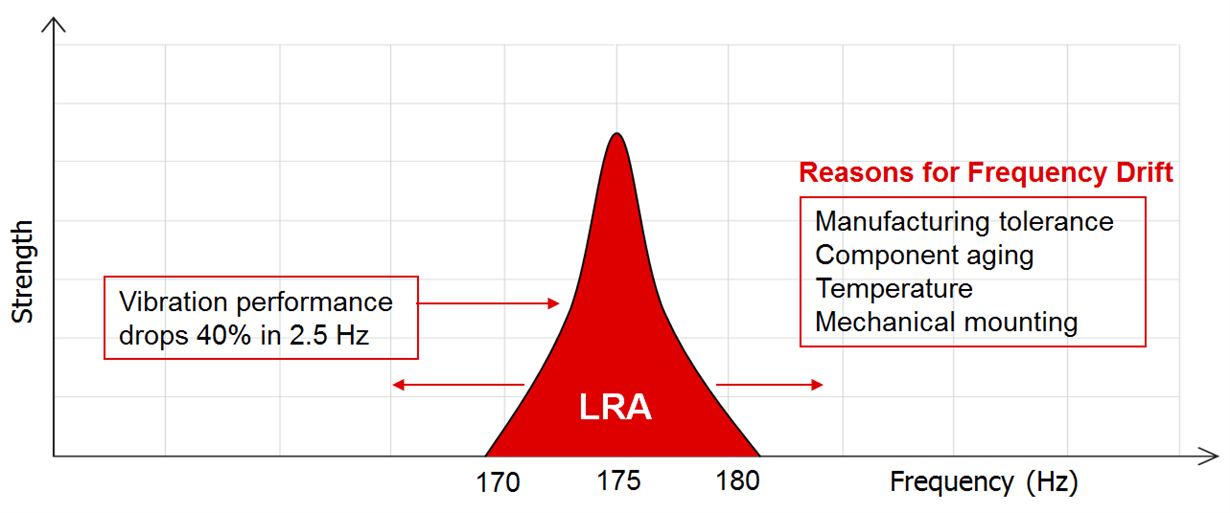SSZTAZ3 August 2016 DRV2624 , DRV2625

In the first installment of this two-part series, I discussed five things you should consider when picking a haptic driver and recent haptic advancements. To close this series off, we will cover the three remaining reasons.
Closed-loop Architecture
As in most systems, closed-loop architectures are the most ideal designs. TI’s closed-loop architecture provides several benefits for driving linear resonance actuators (LRAs) and eccentric rotating masses (ERMs).
ERMs are driven at DC voltage levels, so the resonance-tracking portion of the algorithm is not necessary. Instead, the DRV262x family takes advantage of other properties of the DC motor – mainly the attribute called back electromotive force (EMF). When an ERM is off, the motor produces current that is fed back to the outputs of the DRV262x. This current is used to determine how strong to push the motor for the next cycle. By measuring the back EMF, the DRV262x family reduces the power consumption needed to drive an ERM. Essentially, the TI haptic driver takes advantage of the momentum of the rotating mass and only provides the necessary push to keep the motor’s acceleration constant. This feature leads to power savings when compared to a discrete field effect transistor (FET) solutions.
As you may know, LRAs are high Q systems, meaning that they operate efficiently at a specific frequency. Figure 1 depicts the typical operating frequency of an LRA. Operating an LRA at a frequency just 2.5Hz outside of the resonance frequency can result in a 40% loss of acceleration. TI’s algorithm uses the properties of these LRAs to ensure that the drive frequency is within 2Hz of the actuator’s resonance frequency. The DRV262x can also accommodate a wide range of LRA frequencies from 45Hz to 300Hz. Just like the ERM, the back EMF is used to make sure we drive the LRA to its maximum potential with minimal effort.
 Figure 1 LRA High Q System
Figure 1 LRA High Q SystemPower Consumption
This next feature is arguably the most important feature of the DRV262x family: in shutdown mode, the driver consumes only 105nA. Power consumption for personal electronics, wearables and infotainment consoles is trending downward with technological advancements. Battery capacity continues to grow, but designers need to tackle power consumption from both sides. Since designers are trying to run haptic devices on less power, the TI haptic team is focusing on ultra-low power devices, such as the DRV2624 and DRV2625, which improves power consumption from the previous haptic driver by 10x.
One issue with keeping parts in shutdown mode is the wake-up time. For haptics, it is especially important to provide a fast response time. With the DRV262x haptic driver, users can wake up the part and implement a waveform in 1ms, making the response time miniscule.
Integrated Haptics Library
On a different note, some may not know where to start with haptic feedback; others may know exactly what they want. For those who aren’t sure where to start or are looking for a simple haptic implementation, the DRV2625 ships with a licensed implementation of Immersion’s TouchSense 2200 waveform library. This library contains 123 waveforms that can provide effects from single clicks to ramp-transition clicks for gaming applications or custom haptic feedback alerts. The DRV2625 has the option to implement as many as eight waveforms in a single sequence, and those sequences can be looped in numerous ways to create endless configurations.
For those with haptic experience who want to create custom effects, the DRV2624 ships with 2kB of programmable RAM to create custom effects geared toward video games, virtual reality or other applications. Using a microcontroller, products can have numerous haptic effects stored in a central library and loaded into RAM based on user experiences. This makes the DRV2624 extremely versatile.
Bonus: Controlling Your Driver
The future of integrated electronics will be heavily impacted by the ability to engage customers through the sense of touch. When looking for a place to start with the aforementioned drivers, consider using evaluation modules (EVMs), such as the DRV2625EVM-CT and DRV2624EVM-CT in conjunction with haptic control console (HCC). HCC is a program designed to make using haptic EVMs easy by utilizing an on board MSP430. This software controls every aspect of the DRV262x driver.
Now that you know what to look for when selecting a haptic driver, you should now be able to evaluate the different options and decide what is right for you. The haptic features for an automobile will be different than haptics in a smart watch or mobile device. There are certain features you should be on the lookout for, however.
Let me know what you think of these eight considerations. Would you add others?
Additional Resources
- Visit the haptic portal for more information.
- Read more blog posts on haptics.
- Learn more about haptics in automotive, industrial, mobile and other applications from TI’s solution guides.